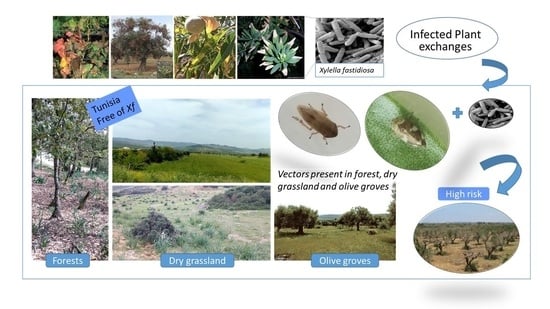Aphrophoridae as Potential Vectors of Xylella fastidiosa in Tunisia
Abstract
Simple Summary
Abstract
1. Introduction
2. Materials and Methods
2.1. Sampling Sites
2.2. Sampling of Spittlebugs
2.3. Morphological Identification
2.4. Distribution and Host Plant Colonization in 2021
3. Results
3.1. Spittlebug Identification and Description
3.1.1. Philaenus Species
3.1.2. Neophilaenus Species
3.2. Spittlebug Frequency According to Year and Region
3.3. Aphrophoridae Composition
3.4. Frequency Variations of Aphrophoridae Species According to Year
3.5. Distribution of Spittlebugs According to Land Type
3.6. Distribution and Breeding of Spittlebugs on Plants in Two Locations during 2021
3.6.1. Dar Chichou Forest
3.6.2. Feija Forest
4. Discussion
- -
- P. tesselatus occurs in six of the nine explored regions (Nabeul, Jendouba, Bizerte, Béja, Zaghouan, Kairouan) with the highest frequency in Jendouba and Nabeul. P. tesselatus is closely related to P. spumarius, differing by the structure of male genitalia [57]. This western Mediterranean species seems to be vicariant to P. spumarius in Tunisia and can be a candidate vector. Perhaps speciation might have started allopatrically in isolated populations of P. spumarius in northwest Africa where it is now absent or very limited and then spread north into the southern Iberian Peninsula in the same manner as P. maghresignus [43]. Such speciation needs a more favorable environment for P. spumarius, perhaps related to temperature within a climatic change context. It seems that the identity of P. spumarius and its presence in Tunisia is questionable, considering also the presence of P. signatus reported in the collection of Lindberg from Tunisia [54]. These two species were not found in the examined samples which remains unclear.
- -
- P. maghresignus is monophagous on A. microcarpus on which both nymphs and freshly emerged adults were present in high densities in spring. The catches of P. maghresignus were in low numbers in late spring and summer which does not reflect the field reality. This suggests the limit of the sweep net sampling for this species is in the underground vegetation. Accordingly, this method cannot give an absolute measure of the insect presence. Its status is not confirmed but Philaenus italosignus is very close to this species and it is a poor vector [29], hence it is not considered as high risk.
- -
- N. campestris occurred in seven regions of Tunisia and N. lineatus in six. N. campestris was frequent in our prospections. This species is able to transmit X. fastidiosa to olive trees in Italy [29]. In Spain it is considered as a serious threat to key crops that are vital for Spanish and French agriculture such as olive, almonds and grapevines [58,59,60]. In Portugal, both spittlebugs were the main species associated with olive groves [58]. In Turkey, N. campestris is one of the identified spittlebugs [61]. N. campestris and P. spumarius were recorded in very low numbers in Greece [62].
- -
- The status of N. lineatus as a vector is yet unknown.
5. Conclusions
Author Contributions
Funding
Data Availability Statement
Acknowledgments
Conflicts of Interest
References
- Pierce, N. The California vine disease. U.S. Dep. Agric. Div. Veg. Pathol. Bull. 1892, 2, 222. [Google Scholar]
- Wells, J.M.; Raju, B.C.; Thompson, J.M.; Lowe, S.K. Etiology of phony peach and plum scald disease. Phytopathology 1981, 71, 1156–1161. [Google Scholar] [CrossRef]
- Lee, R.F.; Beretta, M.J.G.; Hartung, J.H.; Hooker, M.E.; Derrick, K.S. Citrus variegated chlorosis: Confirmation of a Xylella fastidiosa as the causal agent. Summa Phytopathol. 1993, 19, 123–125. [Google Scholar]
- Thomson, S.V.; Davis, M.J.; Kloepper, J.W.; Purcell, A.H. Alfalfa dwarf: Relationship to the bacterium causing Pierce’s disease of grapevines and almond leaf scorch disease. In Proceedings of the (Abstract of the) Third International Congress of Plant Pathology, Munich, West Germany, 16–23 August 1978; p. 65. [Google Scholar]
- Chang, J.; Garnier, M.; Zreik, L.; Rossetti, V.; Bove, J.M. Culture and serological detection of the xylem-limited bacterium causing citrus variegated chlorosis and its identification as a strain of Xylella fastidiosa. Curr. Microbiol. 1993, 27, 137–142. [Google Scholar] [CrossRef]
- Chang, J.; Mast, F.D.; Fagarasanu, A.; Rachubinski, D.A.; Eitzen, G.A.; Dacks, J.B.; Rachubinski, R.A. Pex3 peroxisome biogenesis proteins function in peroxisome inheritance as class V myosin receptors. J. Cell. Biol. 2009, 187, 233–246. [Google Scholar] [CrossRef]
- Grebus, M.E.; Henry, J.M.; Hartin, J.E.; Wilen, C.A. Bacterial leaf scorch of oleander: A new disease in southern California. Phytopathology 1996, 86 (Suppl. 11), S110. [Google Scholar]
- Montero-Astua, M.; Chacon-Diaz, C.; Aguilar, E.; Mario Rodriguez, C.; Garita, L.; Villalobos, W. Isolation and molecular characterization of Xylella fastidiosa from coffee plants in costa rica. J. Microbiol. 2008, 46, 482–490. [Google Scholar] [CrossRef]
- Hernandez-Martinez, R.; Pinckard, T.R.; Costa, H.S.; Cooksey, D.A.; Wong, F.P. Discovery and Characterization of Xylella fastidiosa Strains in Southern California Causing Mulberry Leaf Scorch. Plant Dis. 2006, 90, 1143–1149. [Google Scholar] [CrossRef] [PubMed]
- Lopes, J.R.S.; Daugherty, M.P.; Almeida, R.P.P. Strain origin drives virulence and persistence of Xylella fastidiosa in alfalfa. Plant Pathol. 2010, 59, 963–971. [Google Scholar] [CrossRef]
- Blake, J.H. Distribution of Xylella fastidiosa in Oak, Maple, and Sycamore in South Carolina. Plant Dis. Am. Phytopathol. Soc. 1993, 77, 1262. [Google Scholar] [CrossRef]
- Janse, J.D.; Obradovic, A. Xylella fastidiosa. Its biology, diagnosis, control and risks. J. Plant Pathol. 2010, 92, S35–S48. [Google Scholar]
- Saponari, M.; Boscia, D.; Nigro, F.; Martelli, G.P. Identification of DNA sequences related to Xylella fastidiosa in oleander, almond and olive trees exhibiting leaf scorch symptoms in Apulia (Southern Italy). J. Plant Pathol. 2013, 95, 668. [Google Scholar] [CrossRef]
- Freitag, J.H. Host range of the Pierce’s disease virus of grapes as determined by insect transmission. Phytopathology 1951, 41, 920–934. [Google Scholar]
- Raju, B.C.; Wells, J.M.; Nyland, G.; Brlansky, R.H.; Lowe, S.K. Plum leaf scald isolation, culture and pathogenicity of the causal agent. Phytopathology 1982, 72, 1460–1466. [Google Scholar] [CrossRef]
- Nielson, M.W. The leafhopper vectors of phytopathogenic viruses (Homoptera, Cicadellidae). Taxonomy, biology, and virus transmission. US Agric. Res. Serv. 1968, 1382, 1–386. [Google Scholar]
- Redak, R.A.; Purcell, A.H.; Lopes, J.R.S.; Blua, M.J.; Mizell, R.F.; Andersen, P.C. The biology of xylem fluid-feeding insect vectors of Xylella fastidiosa and their relation to disease epidemiology. Ann. Rev. Entomol. 2004, 49, 243–270. [Google Scholar] [CrossRef]
- Newman, K.L.; Almeida, R.P.; Purcell, A.H.; Lindow, S.E. Cell-cell signaling controls Xylella fastidiosa interactions with both insects and plants. Proc. Natl. Acad. Sci. USA 2004, 101, 1737–1742. [Google Scholar] [CrossRef]
- Jeger, M.; Bragard, C. The epidemiology of Xylella fastidiosa; A perspective on current knowledge and framework to investigate plant host–vector–pathogen interactions. Phytopathology 2019, 109, 200–209. [Google Scholar] [CrossRef]
- Killiny, N.; Prado, S.S.; Almeida, R.P. Chitin utilization by the insect-transmitted bacterium Xylella fastidiosa. Appl. Environ. Microbiol. 2010, 76, 6134–6140. [Google Scholar] [CrossRef]
- Almeida, R.P.P. Xylella fastidiosa vector transmission biology. In Vector-Mediated Transmission of Plant Pathogen, 2nd ed.; Brown, J.K., Ed.; APS Press: St. Paul, MN, USA, 2016; Volume 2, pp. 165–174. [Google Scholar]
- Severin, H. Spittle-insect vectors of Pierce’s disease virus. II. Life history and virus transmission. Hilgardia 1950, 19, 357–382. [Google Scholar] [CrossRef]
- Hill, B.L.; Purcell, A.H. Acquisition and retention of Xylella fastidiosa by an efficient vector, Graphocephala atropunctata. Phytopathology 1995, 85, 209–212. [Google Scholar] [CrossRef]
- EFSA PLH Panel on Plant Health. Scientific opinion on the risks to plant health posed by Xylella fastidiosa in the EU territory, with the identification and evaluation of risk reduction options. EFSA J. 2015, 13, 3989. [Google Scholar] [CrossRef]
- Martelli, G.P.; Boscia, D.F.; Saponari, M. The olive quick decline syndrome in southeast Italy: A threatening phytosanitary emergency. Eur. J. Plant Pathol. 2015, 144, 235–243. [Google Scholar] [CrossRef]
- Cornara, D.; Porcelli, F. Observations on the biology and ethology of Aphrophroridae: Philaenus spumarius in the Salento peninsula. International Symposium on the European Outbreak of Xylella fastidiosa in Olive. J. Plant Pathol. 2014, 96, S4.98. [Google Scholar]
- Saponari, M.; Loconsole, G.; Cornara, D.; Yokomi, R.K.; De Stradis, A.; Boscia, D.; Bosco, D.; Martelli, G.P.; Krugner, R.; Porcelli, F. Infectivity and transmission of Xylella fastidiosa by Philaenus spumarius (Hemiptera: Aphrophoridae) in Apulia, Italy. J. Econ. Entomol. 2014, 107, 1316–1319. [Google Scholar] [CrossRef]
- Cornara, D.; Cavalieri, V.; Dongiovanni, C.; Altamura, G.; Palmisano, F.; Bosco, D.; Porcelli, F.; Almeida, R.P.P.; Saponari, M. Transmission of Xylella fastidiosa by naturally infected Philaenus spumarius (Hemiptera, Aphrophoridae) to different host plants. J. Appl. Entomol. 2016, 141, 80–87. [Google Scholar] [CrossRef]
- Cavalieri, V.; Altamura, G.; Fumarola, G.; di Carolo, M.; Saponari, M.; Cornara, D.; Bosco, D.; Dongiovanni, C. Transmission of Xylella fastidiosa Subspecies Pauca Sequence Type 53 by Different Insect Species. Insects 2019, 10, 324. [Google Scholar] [CrossRef]
- Ossiannilson, F. The Auchenorrhyncha (Homoptera) of Fennoscandia and Denmark. Part 3: The family Cicadellidae: Deltocephalinae, Catalogue, Literature and Index. In Fauna Entomologica Scandinavia; Scandinavian Science Press Ltd.: Klampenborg, Denmark, 1983; Volume 7, pp. 594–979. [Google Scholar]
- Horsfield, D. Evidence for xylem feeding by Philaenus spumarius (L.) (Homoptera: Cercopidae). Entomol. Exp. Et Appl. 1978, 24, 95–99. [Google Scholar] [CrossRef]
- Horsfield, D. Relationships between feeding of Philaenus spumarius (L.) and the amino acid concentration in the xylem sap. Ecol. Entomol. 1977, 2, 259–266. [Google Scholar] [CrossRef]
- Maryańska-Nadachowska, A.; Kajtoch, Ł.; Lachowska, D. Genetic diversity of Philaenus spumarius and P. tesselatus (Hemiptera, Aphrophoridae): Implications for evolution and taxonomy. Syst. Entomol. 2012, 37, 55–64. [Google Scholar] [CrossRef]
- Mundinger, F.G. The control of spittle insects in strawberry plantings. J. Econ. Ent. 1946, 39, 299–305. [Google Scholar] [CrossRef]
- Purcell, A.H. Environmental Therapy for Pierce’s Disease of Grapevines. Plant Dis. 1980, 64, 388–390. [Google Scholar] [CrossRef]
- Puton, A. Catalogue des Hémiptères (Hétéroptères, Cicadines et Psyllides) de la Faune Paléartique; Société Française d’Entomologie: Caen, France, 1886; 121p. [Google Scholar]
- Linnavuori, R. Studies on the south and East Mediterranean Hemipterous Fauna. Acta Entomol. Fenn. 1965, 21, 1–70. [Google Scholar]
- Linnavuori, R.A. Leafhopper material from Tunisia, with remarks on some species of the adjacent countries. Ann. Soc. Entomol. Fr. 1971, 7, 57–73. [Google Scholar]
- Melichar, L. Beitrag zur Kenntniss der Homopteren-Fauna von Tunis. Wien. Ent. Ztg. 1899, 18, 175–190. [Google Scholar]
- Beier, M.; Wagner, W. Zoologische studien in westgriechenland. IX. Teil. Homoptera. Sitzungsber. Osterr. Akad. Wiss. Math. Kl. 1959, 168, 583–605. [Google Scholar]
- Halkka, O.; Lallukka, R. The origin of balanced polymorphism in the spittlebugs (Philaenus, Homoptera). Ann. Zool. Fenn. 1969, 6, 431–434. [Google Scholar]
- Nast, J. Palaearctic Auchenorrhyncha (Homoptera): An Annotated Check List. Institute of Zoology; Polish Academy of Sciences, Polish Scientific Publisher: Warszawa, Poland, 1972; 550p. [Google Scholar]
- Drosopoulos, S.; Remane, R. Biogeographic studies on the spittlebug Philaenus signatus Melichar, 1896 species group (Hemiptera: Aphrophoridae) with the description of two new allopatric species. Ann. Soc. Entomol. Fr. 2000, 36, 269–277. [Google Scholar]
- Drosopoulos, S.; Quartau, J.A. The spittle bug Philaenus tesselatus Melichar, 1899 (Hemiptera, Auchenorrhyncha, Cercopidae) is a distinct species. Zootaxa 2002, 68, 1–8. [Google Scholar] [CrossRef]
- Maryańska-Nadachowska, A.; Kuznetsova, V.G.; Drosopoulos, S.; Lachowska-Cierlik, D. A chromosomal analysis of eight Mediterranean species of Philaenus. Bull. Insectology 2008, 61, 133–134. [Google Scholar]
- Ferrari, P.M. Materiale per lo studio della fauna Tunisina raccoltida G. El. Doria. Ann. Mus. Genova 1884, 1, 439–522. [Google Scholar]
- Graeffe, E. Beiträge zur Insektenfauna von Tunis. Verh, Zool. Bot. Ges. Wien LVI 1906, 446–462. [Google Scholar]
- Fierro, A.; Liccardo, A.; Porcelli, F. A lattice model to manage the vector and the infection of the Xylella fastidiosa on olive trees. Sci. Rep. 2019, 9, 8723. [Google Scholar] [CrossRef] [PubMed]
- Liccardo, A.; Fierro, A.; Garganese, F.; Picciotti, U.; Porcelli, F. A biological control model to manage the vector and the infection of Xylella fastidiosa on olive trees. PLoS ONE 2020, 15, e0232363. [Google Scholar] [CrossRef] [PubMed]
- Oman, P.W. The Nearctic Leafhoppers (Homoptera: Cicadellidae), A Generic Classification and Check List; Entomological Society of Washington: Washington, DC, USA, 1949; Volume 3, pp. 1–253. [Google Scholar]
- Nye, W.P. A Simple Method for Mounting Aphids. Pan-Pac. Entomol. 1947, 23, 73–74. [Google Scholar]
- Ossiannilsson, F. The Auchenorrhyncha (Homoptera) of Fennoscandia and Denmark. In Part 2: Cicadidae, Cercopidae, Membracidae, Cicadellidae; Scandinavian Science Press Ltd.: Klampenborg, Denmark, 1978; 378p. [Google Scholar]
- Biederman and Niedringhaus. The Plant-and Leafhoppers of Germany. In Identification Key to All Species; WABV-Fründ: Scheeßel, Germany, 2009; 409p. [Google Scholar]
- Lindberg, H. Hemiptera from the Azores and Madeira. Bol. Mus. Munic. Funchal 1960, 13, 85–94. [Google Scholar]
- Drosopoulos, S.; Maryanska-Nadachowska, A.; Kuznetsova, V.G. The Mediterranean: Area of origin of polymorphism and speciation in the spittlebug Philaenus (Hemiptera, Aphrophoridae). Zoosystematics Evol. 2010, 86, 125–128. [Google Scholar] [CrossRef]
- Drosopoulos, S. New data on the nature and origin of colour polymorphism in the spittlebug genus Philaenus (Hemiptera: Aphorophoridae). Ann. Soc. Entomol. Fr. 2003, 39, 31–42. [Google Scholar] [CrossRef]
- Seabra, S.G.; Rodrigues, A.S.B.; Silva, S.E.; Neto, A.C.; Pina-Martins, F.; Marabuto, E.; Thompson, V.; Wilson, M.R.; Yurtsever, S.; Halkka, A.; et al. Population structure, adaptation and divergence of the meadow spittlebug, Philaenus spumarius (Hemiptera, Aphrophoridae), revealed by genomic and morphological data. PeerJ 2021, 9, e11425. [Google Scholar] [CrossRef]
- Morente, M.; Cornara, D.; Plaza, M.; Manuel Durán, J.; Capiscol, C.; Raquel, T.; Ruiz, M.; Ruz, C.; Sanjuan, S.; Pereira, J.A.; et al. Distribution and Relative Abundance of Insect Vectors of Xylella fastidiosa in Olive Groves of the Iberian Peninsula. Insects 2018, 9, 175. [Google Scholar] [CrossRef]
- Lago, C.; Morente, M.; De las Heras-Bravo, D.; Martí-Campoy, A.; Rodríguez-Ballester, F.; Plaza, M.; Moreno, A.; Fereres, A. Dispersal of Neophilaenus campestris, a vector of Xylella fastidiosa, from olive groves to over-summering hosts. J. Appl. Entomol. 2021, 145, 648–659. [Google Scholar] [CrossRef]
- Chauvel, G.; Cruaud, A.; Legendre, B.; Germain, J.F.; Rasplus, J.Y. Rapport de Mission D’expertise sur Xylella Fastidiosa en Corse. 2015. Available online: http://agriculture.gouv.fr/sites/minagri/files/20150908_rapport_mission_corse_xylella_31082015b.pdf (accessed on 31 August 2015).
- Ozgen, I.; Topdemir, A.; Mozaffarian, F. Additional notes on the some aphrophorid spittlebugs of eastern Anatolia (Hemiptera: Cercopidae: Aphrophoridae). Int. J. Innov. Eng. Appl. 2018, 2, 60–61. [Google Scholar]
- Koufakis, I.; Pappas, M.; Kalaitzaki, A.; Tsagkarakis, A.; Tzobanoglou, D.; Perdikis, D.; Broufas, G. Philaenus spumarius (L.) (Homoptera: Aphrophoridae) and other potential insect vectors of Xylella fastidiosa in Western Crete (Greece) olive groves. Integrated Protection of Olive Crops. IOBC-WPRS Bull. 2019, 141, 82–86. [Google Scholar]
- Mazzoni, V. Contribution to the knowledge of the Auchenorrhyncha (Hemiptera Fulgoromorpha and Cicadomorpha) of Tuscany (Italy). Redia 2005, 88, 85–102. [Google Scholar]
- Weaver, C.R.; King, D.R. Meadow spittlebug, Philaenus leucophthalmus (L.). Ohio Agric. Exp. Stn. Res. Bull. 1954, 741, 99. [Google Scholar]
- Albre, J.; Garcia Carrasco, J.M.; Gibernau, M. Ecology of the meadow spittlebug Philaenus spumarius in the Ajaccio region (Corsica)-I: Spring. Bull. Entomol. Res. 2020, 111, 1–11. [Google Scholar] [CrossRef]
- Bodino, N.; Cavalieri, V.; Dongiovanni, C.; Saladini, M.A.; Simonetto, A.; Volani, S.; Plazio, E.; Altamura, G.; Tauro, D.; Gilioli, G.; et al. Spittlebugs of Mediterranean olive groves: Host-plant exploitation throughout the year. Insects 2020, 11, 130. [Google Scholar] [CrossRef]
- Haddad, N.; Afechtal, M.; Streito, J.C.; Ouguas, Y.; Benkirane, R.; Lhomme, P.; Smaili, M.C. Occurrence in Morocco of potential vectors of Xylella fastidiosa that may contribute to the active spread of the bacteria. Ann. Soc. Entomol. Fr. 2021, 57, 359–371. [Google Scholar] [CrossRef]
- Lopes, J.R.S.; Landa, B.B.; Fereres, A. A survey of potential insect vectors of the plant pathogenic bacterium Xylella fastidiosa in three regions of Spain. Span. J. Agric. Res. 2014, 12, 795–800. [Google Scholar] [CrossRef]
- Neto, A.C. Potential Vectors of Xylella fastidiosa in Portuguese Olive Orchards: Survey in Alentejo Region and Control Measures. Master’s Thesis, Universidade de Lisboa, Lisbon, Portugal, 2017. [Google Scholar]
- Purcell, A.H.; Finlay, A.H.; McLean, D.L. Pierce’s disease bacterium: Mechanism of transmission by leafhopper vectors. Science 1979, 206, 839–841. [Google Scholar] [CrossRef]
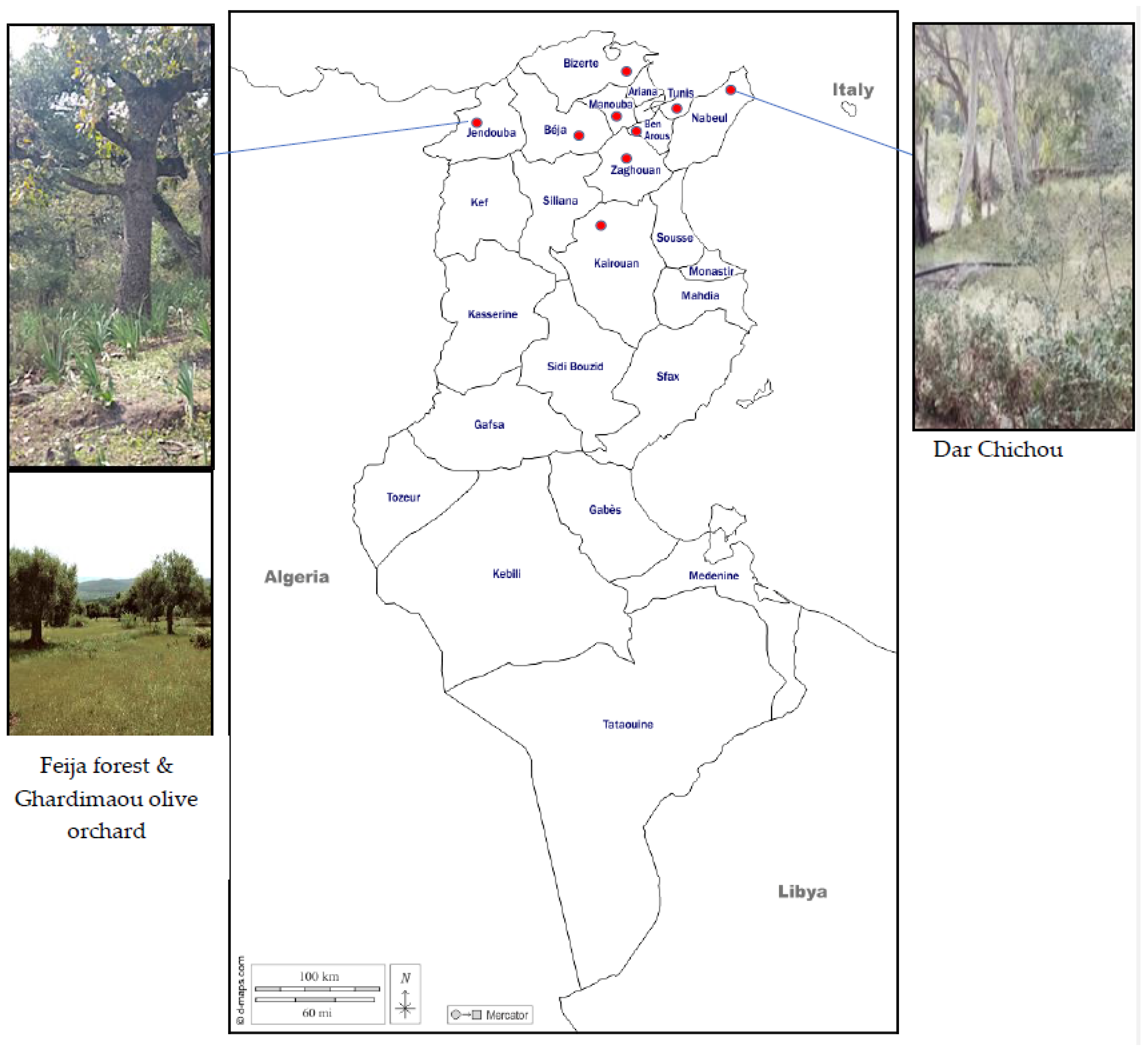
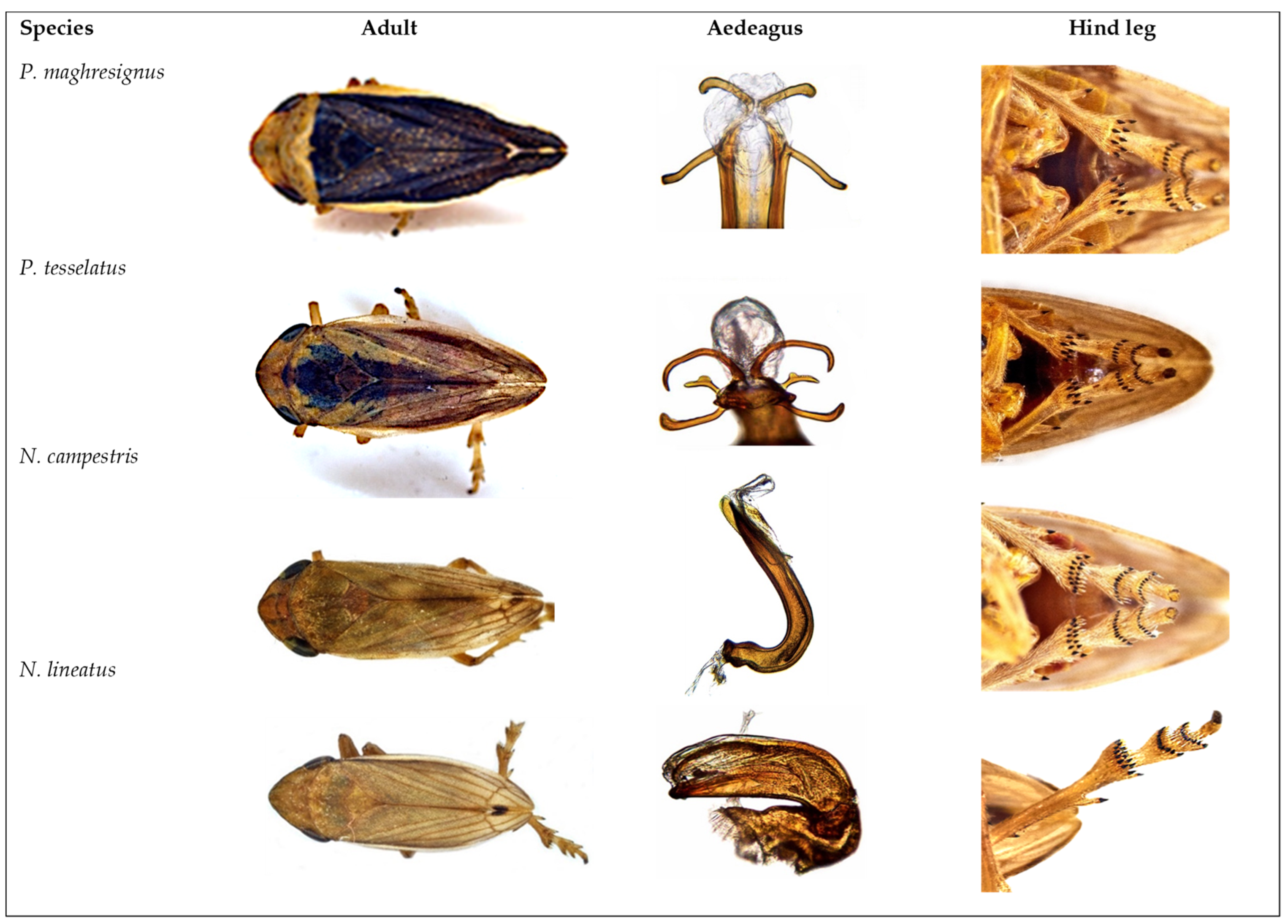
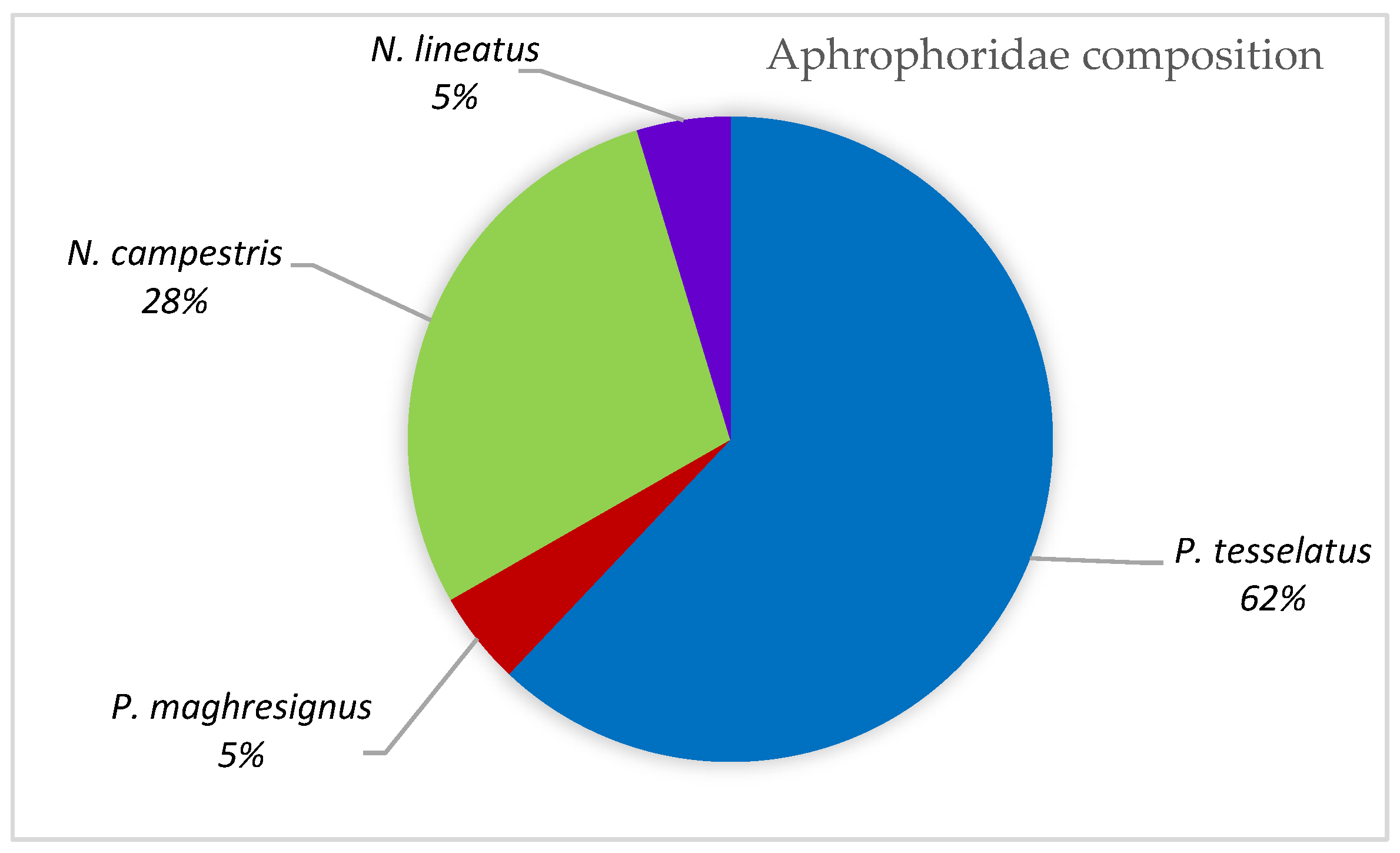
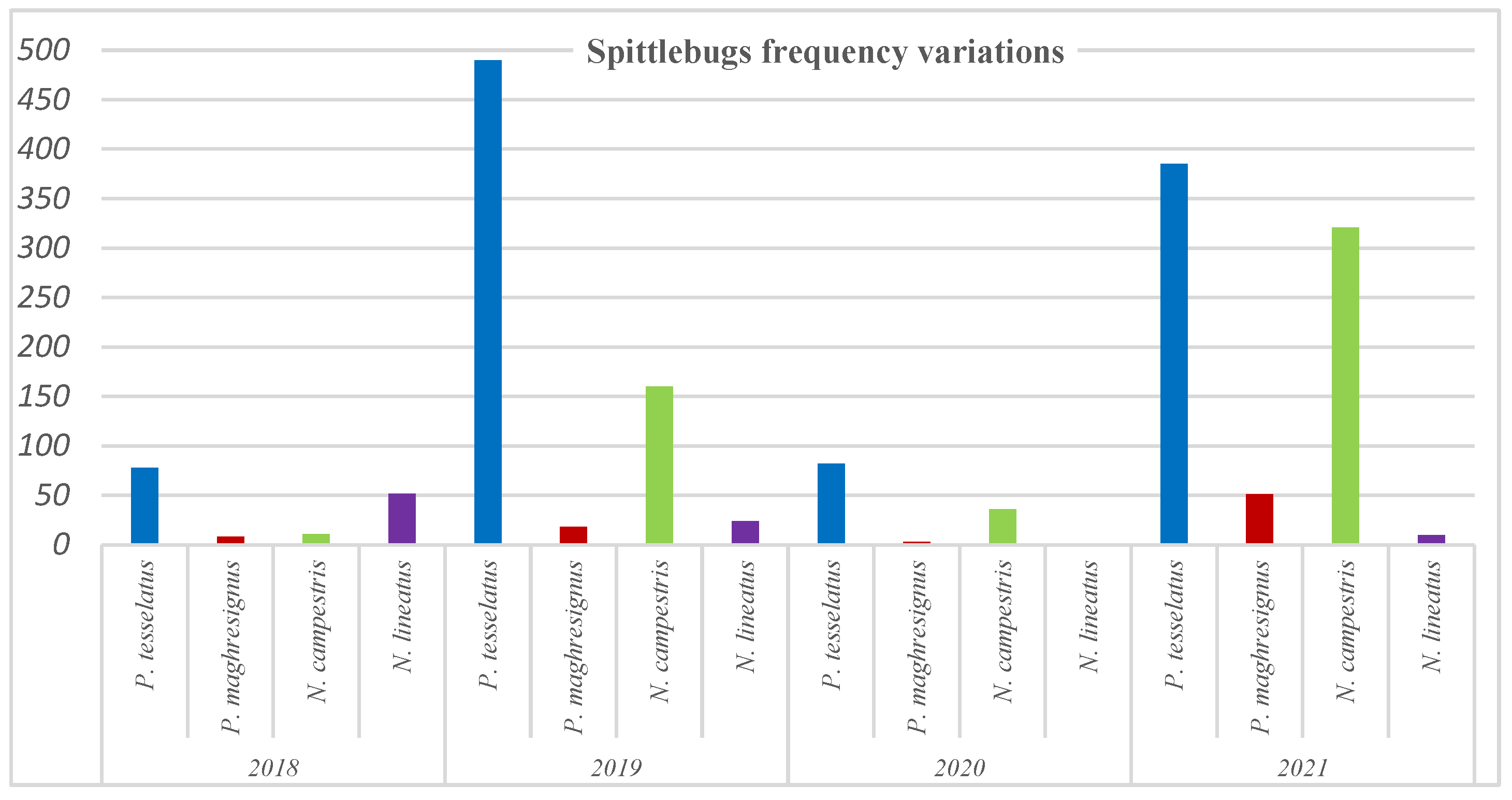
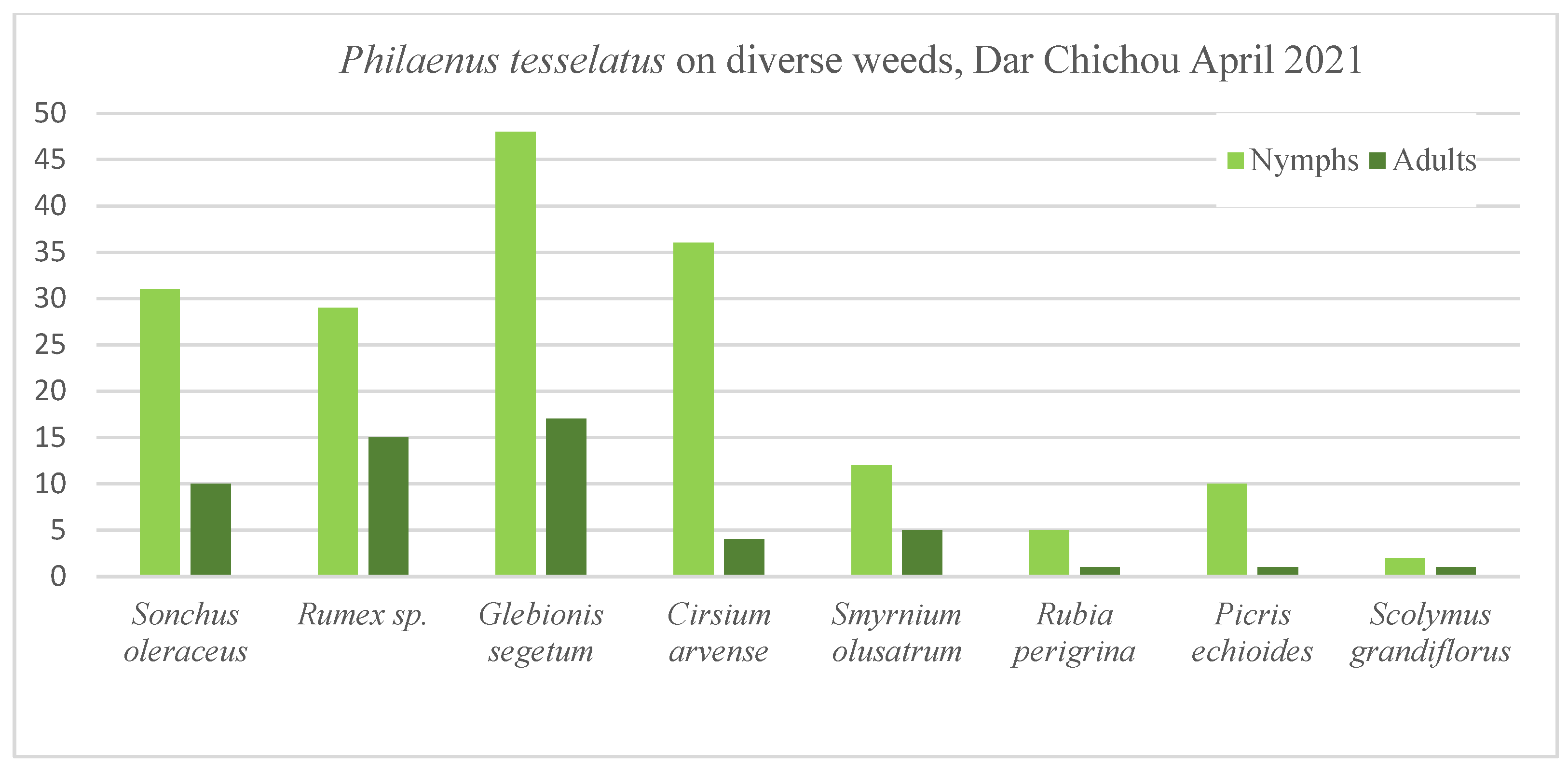
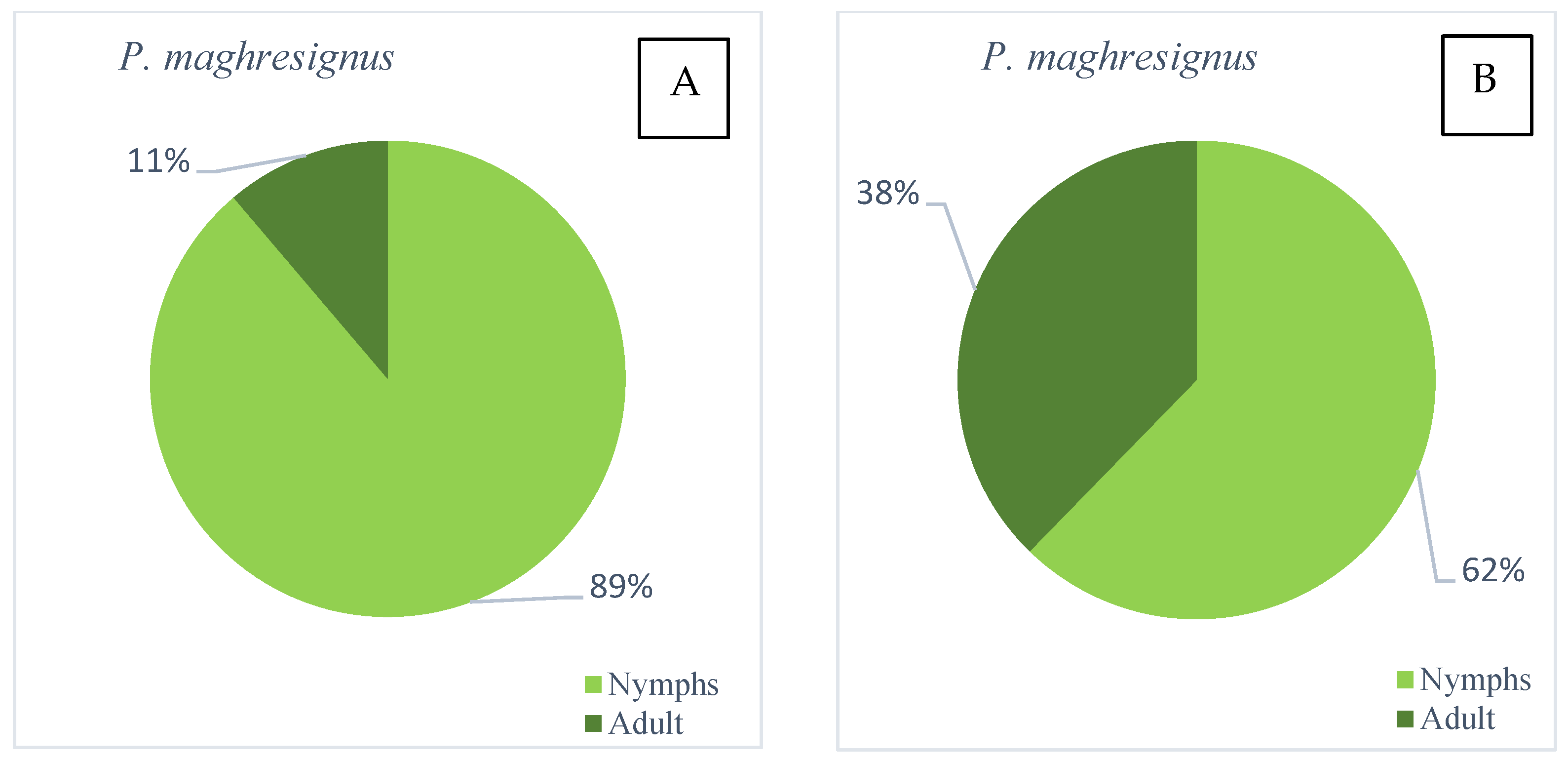

| Regions | Forests/Natural Reserve | Dry Grassland | Fruit Orchards |
|---|---|---|---|
| Nabeul | Dar Chichou, Korbous, Kef Errand, Bou Argoub, Jebel Abderrahmen, Zougag | Douala, Brij, Haouaria, Tekelsa | Menzel Bouzelfa (olive), Douala (citrus and peach), Soliman (olive), Taffela (olive and grape vine) |
| Bizerte | Jebel Ichkeul and Lake, Rimel, Teskreya, Corniche | Khetmine, Pont de Bizerte, Utique, Alia, Sejnane | Mateur, Ain Ghlal (peach), Menzel Bourguiba (olive), Sidi Othman (olive), Azib (citrus) |
| Béja | Cap Negro, Chitana, Khroufa, Jebba | Nefza, Tebaba, Ain Essobh, Ouchtata | Jebba, Ouchtata (olive) |
| Jendouba | Feija, Ain Draham | Tabarka, Oued Snoussi, Balta, Fernana | Bousalem (peach, citrus, grape vine), Ghardimaou (olive), Ain Soltan (olive) |
| Zaghouan | Jebel Zaghouan, Oued el Galb | Fahs | Zriba, Fahs, Jebel el Ouest |
| Kairouan | Sidi Mahmoud-Oueslatia | Chebika (citrus, peach) | |
| Ben Arous | Jebel Boukornine | Ben Arous (olive, grape vine), Mornag (peach) | |
| Tunis | Belvédère park, Gammart | ||
| Manouba | Batan, Saida, Jdaida | Mehrine (olive tree), Borj el Amri |
| Seasons | Males | Jendouba | Nabeul | Bizerte | Béja | Zaghouan | Kairouan | Manouba | Ben Arous | Tunis | T |
|---|---|---|---|---|---|---|---|---|---|---|---|
| Summer 2018 | P. tesselatus | 13 | 45 | 2 | 14 | 3 | - | - | 1 | - | 78 |
| P. maghresignus | - | 7 | - | 1 | - | - | - | - | - | 8 | |
| N. campestris | 1 | 2 | 6 | 1 | 1 | - | - | - | - | 11 | |
| N. lineatus | 1 | 8 | 37 | 2 | 4 | - | - | - | - | 52 | |
| Spring 2019 | P. tesselatus | 70 | 326 | 6 | 4 | 1 | 1 | - | - | - | 408 |
| P. maghresignus | 3 | 11 | - | 1 | - | - | - | - | - | 15 | |
| N. campestris | - | 7 | 112 | 2 | 1 | 2 | - | - | - | 124 | |
| N. lineatus | - | - | 18 | - | - | - | - | - | - | 18 | |
| Summer 2019 | P. tesselatus | 44 | 36 | - | 2 | - | - | - | - | - | 82 |
| P. maghresignus | 4 | - | - | - | - | - | - | - | - | 4 | |
| N. campestris | - | 9 | 24 | 3 | - | - | - | - | - | 36 | |
| N. lineatus | - | - | - | - | - | - | - | - | - | 0 | |
| Summer 2020 * | P. tesselatus | 137 | 40 | 2 | 9 | - | - | - | - | - | 188 |
| P. maghresignus | 6 | 1 | - | 2 | - | - | - | - | - | 9 | |
| N. campestris | 28 | 2 | 1 | 3 | - | - | - | - | - | 34 | |
| N. lineatus | - | - | - | - | - | - | - | - | - | 0 | |
| Spring 2021 | P. tesselatus | 97 | 231 | - | - | - | - | - | - | - | 328 |
| P. maghresignus | 18 | 5 | 19 | - | - | - | - | - | - | 42 | |
| N. campestris | 292 | 13 | - | - | - | - | 1 | - | - | 306 | |
| N. lineatus | 5 | 2 | - | - | - | - | - | 1 | - | 8 | |
| Summer 2021 | P. tesselatus | 38 | 14 | - | 5 | - | - | - | - | - | 57 |
| P. maghresignus | 9 | - | - | - | - | - | - | - | - | 9 | |
| N. campestris | 5 | 8 | 1 | 1 | - | - | - | - | - | 15 | |
| N. lineatus | - | - | 7 | - | - | - | - | - | - | 7 | |
| Total | 771 | 767 | 235 | 50 | 10 | 3 | 1 | 2 | 0 | 1839 |
| Region | Forest | Dry Grassland | Fruit Orchards |
|---|---|---|---|
| P. tesselatus | 99.8% | 0 | 0.2% (2 grapevines) |
| P. maghresignus | 100% | 0 | 0 |
| N. campestris | 26.2% | 22.7% | 51.1% (olive) |
| N. lineatus | - | 98.8% | 1.2% (olive) |
| Total | 74.1% | 11.1% | 14.8% |
Disclaimer/Publisher’s Note: The statements, opinions and data contained in all publications are solely those of the individual author(s) and contributor(s) and not of MDPI and/or the editor(s). MDPI and/or the editor(s) disclaim responsibility for any injury to people or property resulting from any ideas, methods, instructions or products referred to in the content. |
© 2023 by the authors. Licensee MDPI, Basel, Switzerland. This article is an open access article distributed under the terms and conditions of the Creative Commons Attribution (CC BY) license (https://creativecommons.org/licenses/by/4.0/).
Share and Cite
Boukhris-Bouhachem, S.; Souissi, R.; Abou Kubaa, R.; El Moujabber, M.; Gnezdilov, V. Aphrophoridae as Potential Vectors of Xylella fastidiosa in Tunisia. Insects 2023, 14, 119. https://doi.org/10.3390/insects14020119
Boukhris-Bouhachem S, Souissi R, Abou Kubaa R, El Moujabber M, Gnezdilov V. Aphrophoridae as Potential Vectors of Xylella fastidiosa in Tunisia. Insects. 2023; 14(2):119. https://doi.org/10.3390/insects14020119
Chicago/Turabian StyleBoukhris-Bouhachem, Sonia, Rebha Souissi, Raied Abou Kubaa, Maroun El Moujabber, and Vladimir Gnezdilov. 2023. "Aphrophoridae as Potential Vectors of Xylella fastidiosa in Tunisia" Insects 14, no. 2: 119. https://doi.org/10.3390/insects14020119
APA StyleBoukhris-Bouhachem, S., Souissi, R., Abou Kubaa, R., El Moujabber, M., & Gnezdilov, V. (2023). Aphrophoridae as Potential Vectors of Xylella fastidiosa in Tunisia. Insects, 14(2), 119. https://doi.org/10.3390/insects14020119






